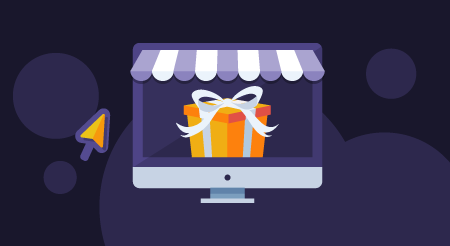To say 2020 was a hard year for small businesses is the biggest understatement since James Lovell said, “Houston, we’ve had a problem.”
As a retailer and small-business owner, you know exactly what the struggle has been—I don’t have to tell you about the thousands of businesses that had to permanently close their doors due to the pandemic. But there were also businesses that were able to make changes and see success during this period. I want to tell you about those stories.
For so many, 2020 was a year of adaptation and survival. We saw small and midsize businesses (SMBs) turning on a dime to adjust their operating models: investing in and rolling out software to enable remote operations, supporting their staff with virtual collaboration tools, and providing safe, contactless experiences for the consumer while still maintaining a great service experience.
And one of the biggest ways these successful businesses did all those things was by transitioning from a traditional business model to clicks and bricks.
What are clicks and bricks?
Clicks and bricks, also known as click and mortar, hybrid retail models, or sometimes BOPIS retail (buy online, pick up in store), is a business model that combines both online and in-person operations.
The most accessible example is curbside pickup. With this setup, a retailer allows their customers to visit a store online and make their purchase—doing everything from shopping to paying and scheduling the pickup—and then, all they have to do to collect their item is park in a designated spot outside the store and send a text message confirming their arrival. An employee then runs the item out to the customer so they never have to leave their car. It’s an entirely contactless pickup that keeps both the shopper and the employee safer.
Businesses and customers preferred BOPIS retail in 2020
Thanks to the social distancing and mask mandates issued by state and local governments, contactless customer encounters very quickly became the standard for retailers, and successful businesses were quick to implement them in 2020. And how did these businesses make such a major change to their business model so quickly? With technology.
In a survey we conducted of over 500 small businesses in the U.S., we found that 76% of businesses said “all” or “most” of their internal operations transitioned to virtual or remote at the start of the COVID-19 pandemic, and 70% said “all” or “most” of their contact with clients is now being conducted virtually or remotely.


Obviously, these changes had to be made incredibly quickly, which is not the timeline anyone wants when researching, comparing, and (most importantly) investing in new software. But paradoxically, it was software that made these rapid operational changes possible for so many businesses, once they cleared the hurdle of selecting their new software.
Thanks to established software platforms such as ecommerce tools, online payment portals, supply chain management software, video conferencing systems, and customer relationship management software—and so many other types of technologies—businesses were able to take advantage of the software features they adopted almost immediately. That, in turn, empowered businesses to begin quickly providing the types of contactless services their customers needed in 2020.
And that’s exactly what they did. Our survey found that an astounding 84% of small businesses adopted new software last year.

The type of software these businesses invested in varied, but these tools went a long way to keep businesses alive and help them accomplish their specific goals, as we’ll see in the next section.
How software helped businesses in 2020
In our survey, we asked SMBs about the biggest benefits they saw from software adoption last year. The top three answers were increased productivity, improved engagement with customers, and increased sales.

We also asked businesses that adopted new software in 2020 how long they used it before achieving their desired results.

We found that most saw results between three and six months, and 87% had achieved their goals by the nine-month mark. Only 2% had not yet reached the goals they purchased software for.
With businesses seeing such quick return on investment, and especially considering the level of disruption SMBs faced in 2020, it’s no wonder so many invested in new business software tools last year.
The future of hybrid retail business models
We’ve talked a lot about how software helped small businesses survive the unprecedented year in 2020; however, as the vaccine rolls out across the country and social distancing mandates begin to loosen, it’s important to realize that there is no going back on a lot of these new business practices.
Consumers have gotten used to clicks and bricks and the BOPIS retail model, and online ordering and curbside pickup remain a convenient way to shop, regardless of the status of COVID-19.
It’s up to each individual retailer to continue utilizing software tools to meet their customers and employees in this new normal. And based on our survey, that’s exactly what SMBs plan to do.
More than three in four respondents say software and technology will be a core part of their businesses and strategies moving forward.

Additionally, we asked respondents how this year’s software and tech budget will relate to 2020 budgets. We found that the majority of SMBs plan to spend about the same amount or more on software this year as they did in 2020.

Finally, we asked respondents in our survey which actions they’re prioritizing for 2021. Here’s what we found:

Unsurprisingly, establishing a delivery or curbside program (a.k.a a BOPIS, clicks and bricks, bricks and mortar, or hybrid retail model) was the top priority for small businesses this year.
How to successfully transition to clicks and bricks
If you’re one of the small businesses considering a change in business practices to brick and mortar or clicks and bricks, the respondents in our survey have some wise advice for what to prioritize during the transition.

We asked SMBs which actions they took when converting their businesses to digital last year and how valuable each of those actions were. The top priorities were:
- Communicating business changes to customers.
- Shifting from in-person meetings to virtual ones.
- Enabling online checkout and payment (e.g., switching to online checkout).
- Converting existing operational processes to support social distancing requirements (e.g., contactless delivery of pickup).
Taking these priorities from experienced business owners into account, we’ve created the following checklist to help you make the transition to BOPIS retail.

The following articles will be helpful as you move through this process to adopt a click-and-brick business model:
When you’re ready to begin researching software to help with your click-and-brick transition, our advisors are here to help. You can schedule a call or chat to discuss factors such as the features you need and what you’re willing to pay, and at the end of the conversation you’ll receive a short list of products that match your criteria.
Survey methodology
The Software Advice Small Business Comeback Survey was conducted in January 2021. We surveyed 527 small-business “leaders,” defined as full-time business owners, leaders, or entrepreneurs in small-to-midsize companies in the U.S. with up to 500 employees.
We used screening questions to narrow our respondents into those with relevant experience and expertise, and we worded the questions to ensure that each respondent fully understood the meaning and the topic at hand.
Need Any Technology Assistance? Call Pursho @ 0731-6725516




